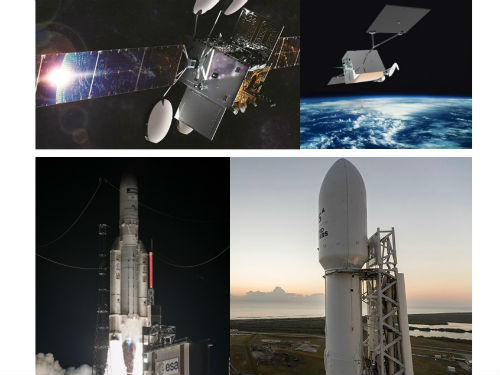Broadband’s Space Race Heats Up
February was a busy month in the world of satellite broadband as a new speedy service was launched, a pair of demo satellites were slung into low earth orbit, and another high-capacity bird took a step toward the launch pad.

-The most significant of these was this week’s launch of a new 100 Mbps (downstream) service from Viasat that enters play roughly nine months after the satellite that is beaming that capacity, ViaSat-2, was launched from Kourou, French Guiana, aboard Arianspace’s Ariane 5 heavy-lift launch vehicle and placed into geosynchronous orbit.
While the new offering will provide unlimited data (customers could see slower speeds in period of congestion after they exceed a monthly soft data ceiling), it’s not cheap either – offered at a promotional price of $150 per month that rises to $200 per month after three months.
-EchoStar’s Hughes Network Systems division said it has reached the preliminary design phase on Jupiter 3 (EchoStar XXIV), another high-capacity satellite that will be capable of delivery 100 Mbps or more. Service on Jupiter 3 isn’t expected to start until 2021.
-A week ago (February 22), Elon Musk’s SpaceX launched two “demonstration” Starlink satellites that are part of an effort to eventually offer broadband using a constellation of thousands of LEO satellites.
Musk also tweeted an update as those two satellites – called Tintin A and Tintin B -- were deployed, later joking that the WiFi passwords for them is “martians”:
First two Starlink demo satellites, called Tintin A & B, deployed and communicating to Earth stations pic.twitter.com/TfI53wHEtz
— Elon Musk (@elonmusk) February 22, 2018
In addition to providing extensive broadband coverage, the LEO approach aims to also cut down one of the issues that’s typical of satellite broadband: latency.
Despite SpaceX’s high-flying ambitions,The Wall Street Journal reported recently that the complexities of the project could play a role in extending the timetable, and that SpaceX still doesn’t have a good fix on what the ultimate costs will be.
Though SpaceX hasn’t announced a new schedule, the current, tentative goal is to start “limited service by 2020 now appears unrealistic,” the paper added, also citing documents from 2015 suggesting that Musk & Co. had projected that the satellite broadband biz is in position to have more than 40 million subs and pull down more than $30 billion in revenues by 2025.
-OneWeb, another LEO-focused satellite broadband initiative backed by investors such as Intelsat, Virgin Qualcomm, SoftBank and Hughes, hasn’t broken any news lately, though Hughes did note that it’s providing gateway equipment for OneWeb’s ground network under a contract currently worth $300 million, and that it might pursue rights to offer service on OneWeb’s network. OneWeb, which has plans to launch hundreds of light, mass-production satellites, plans to support more than 7 Tbps of total capacity in the first phase of the system.
Given the launch of a new 100-meg consumer broadband service, Viasat CEO Mark Dankberg was making the rounds in the media. And, as you might expect, he was asked to weigh in on the competitive threat posed by projects like SpaceX’s.
Speaking on CNBC’s Squawk on the Street, he said SpaceX will present competition “eventually…if they can build a few hundred or a thousand more of them and get them into space.”
Though LEO constellations promise to deliver lower latencies, he also held that Viasat’s use of satellites in geosynchronous orbit bring other benefits.
Larger, geosynchronous satellites like Viasat’s, he said, are placed into fairly safe orbits that don’t change with respect to the Earth or to other GEO satellites. By comparison, LEO systems will be more complex – there will be many more of them, and they will be constantly moving irrespective to each other and to the Earth.
Dankberg agreed there’s some sorting out needed with respect to security and privacy issues when asked what would happen if international law fell behind the pace of technology.
“That is a big issue, and there’s really no global agency that’s dealing with that,” he said.
He also shed some light on the economics of Viasat’s business. Though people make a big deal about launch prices, it’s not the most expensive part of the equation, compared to the satellite itself and the extensive ground fiber network that underpins the system.
[Images: Top (left to right): Renderings of the ViaSat-2 satellite and OneWeb low-earth orbit satellite. Bottom (left to right): The Arianspace Ariane 5 launch vehicle, and SpaceX's Falcon 9 two-stage rocket.]
Multichannel Newsletter
The smarter way to stay on top of the multichannel video marketplace. Sign up below.
